A classic gluten-free German chocolate cake with layers of decadently rich chocolate cake, toasted coconut pecan custard frosting, and a swirl of chocolate buttercream.
This post is brought to you by Bob’s Red Mill, a long-term partner of Snixy Kitchen
Add this gluten-free German chocolate cake to your Easter, Mother's Day, or just-because baking plans! For some reason, I associate shredded coconut with spring baking, but it might only be because it's often used as bunny fur or bird nests atop cakes. That seems as good a reason as any to declare this the perfect spring cake for chocolate lovers.
Unless you're reading this in the summer/fall/winter, in which case, the deep dark chocolate cake and butterscotch-like coconut pecan frosting make this the perfect anytime cake.
Its gluten-free chocolate cake layers are rich and moist, the perfect backdrop for the star of the show: a caramel-y toasted coconut pecan custard frosting. A swirl of chocolate buttercream on top adds a sweet creamy chocolate that ties it all together.
I've developed this gluten-free German chocolate cake as part of my year-long partnership with Bob’s Red Mill. Here’s a list of all the recipes I’ve made in partnership with Bob’s Red Mill over the years.
What is German Chocolate Cake
German Chocolate Cake is a dark chocolate cake layered up with a sticky coconut pecan custard and sometimes topped with chocolate buttercream. The chocolate cake layers are decadently rich and the signature coconut pecan frosting tastes like a toasty and nutty sweet caramel.
Why is it called German Chocolate Cake
As classic and well-known as German Chocolate Cake is, its name is quite deceptive. While one may think that German chocolate cake has roots in Germany, it actually originates in the US. Instead, the cake is named after a chocolate maker named Samuel German who invented a special dark baking chocolate for the Baker's Chocolate Company in the 1800s.
In the 1950's, a Dallas woman published a cake recipe titled German's Chocolate Cake in a local paper that called for that special dark baking chocolate. The recipe spread in popularity and was reprinted in other newspapers across the country, coming to be known simply as German Chocolate Cake.
How to Make Gluten-Free German Chocolate Cake
Many modern takes on German Chocolate Cake, including this gluten-free version, no longer call for baking chocolate. Instead, the name German Chocolate Cake has become synonymous with its flavor profile: a deep dark chocolate cake layered with coconut pecan frosting and chocolate buttercream. Let's break it down.
Moist Gluten-Free Chocolate Cake
While the original German's Chocolate Cake uses butter, more modern chocolate cakes call for oil, which lends itself to a moister crumb. Rather than melted baking chocolate, my gluten-free version uses dutch-processed cocoa powder to create a rich chocolate cake with a moist tender crumb.
The base for this cake is adapted from my favorite gluten-free chocolate cake. Rather than granulated sugar and milk, this version instead uses dark brown sugar and sour cream to add more moisture and structure to the cake, allowing it to withstand the weight of the coconut pecan custard filling and topping.
Coconut Pecan Custard
The quintessential element of a German chocolate cake is the coconut pecan frosting. Shredded coconut and pecans get folded into a custard made of evaporated milk, sugar, butter, and egg yolks. The result is less like frosting in the traditional sense and more like a thick creamy chunky caramel-y custard.
While most recipes call for sweetened coconut, my version uses Bob's Red Mill's unsweetened shredded coconut. The texture of unsweetened shredded coconut is fine and not at all stringy or chewy like sweetened coconut, but instead seems to melt when you eat it. It also creates a less cloyingly sweet frosting with more depth of flavor.
For the same reason, I prefer to use dark brown sugar rather than granulated sugar, giving the frosting a deeper, more butterscotch-like flavor. For best results, look for organic dark brown sugar which has a higher molasses content.
Let the custard frosting cool completely before slathering it between the layers of chocolate cake. It'll thicken up as it cools.
Chocolate Buttercream
Different recipes will vary on whether they call for a layer of chocolate buttercream in addition to the coconut pecan custard. I find the buttercream to be the key to balancing the flavors and texture of the deep dark chocolate cake with the sweet coconut pecan custard.
Just a creamy buttercream layer on top will do the trick! Topped with more coconut pecan custard of course.
Toasted Pecans and Coconut
The crucial element to creating a mindblowing coconut pecan custard frosting is to toast both the pecans and unsweetened coconut. Both will contribute a toasty nuttiness while creating a more pleasing crunchy texture in the creamy frosting.
What Kind of Flour for Gluten-Free German Chocolate Cake
When baking gluten-free cake, I prefer to make my own flour blend, which allows me to maximize flavor and texture, while using whole grain flours. In this chocolate cake, I use gluten-free oat flour, sweet rice flour, and millet flour.
For all of these flours, I recommend Bob's Red Mill brand flours, which are high-quality and have a consistent grind. Below I describe each flour and also recommend a few substitutions if you can't find that particular flour. Alternatively, you can substitute all of the flours in this recipe by weight with Bob's Red Mill 1-to-1 all-purpose gluten-free flour blend.
GLUTEN-FREE OAT FLOUR
Gluten-Free oat flour adds the lightness and structure for the fluffy crumb. It keeps the cake sponge super moist, but not dense.
- Option: grind up gluten-free rolled oats in a food processor or blender, then sift out any big pieces. Make sure to measure this by weight as homemade gluten-free oat flour is less finely ground so the volume per weight will be different.
- Sub in by weight: Bob's Red Mill 1-to-1 all-purpose gluten-free flour blend.
SWEET RICE FLOUR
Made from sticky rice, sweet rice flour is distinctively different than white rice flour or brown rice flour, and despite its name, it's not sweet. Sweet rice flour is the same flour used to make mochi, and as such, its stickiness helps to bind the cake together, creating chewiness like a classic cake recipe. Make sure the rice flour your grab says "sweet rice flour" and not "white rice flour," which will have drastically different baking results.
- I don't recommend substituting the sweet rice flour as I find it's essential to the recipe, but you might have success replacing it with Bob's Red Mill 1-to-1 all-purpose gluten-free flour blend.
MILLET FLOUR
Millet flour is a neutral flour here to balance the others out so the cake isn't too moist or gummy.
- Sub in by weight: teff flour, brown or white rice flour, or Bob's Red Mill 1-to-1 all-purpose gluten-free flour blend.
- Sub in 32g coconut flour: I tested a version with coconut flour to play up the coconut flavor in the filling. The results are almost indistinguishable. When subbing coconut flour, you need less coconut flour because it is much more absorbent.
Does this gluten-free cake need xanthan gum
Nope! The combination of flours along with the soft cakiness of the cocoa powder adds enough structure to create a cake crumb that's light with the classic chew of traditional gluten-filled cake.
What kind of Cocoa Powder for German Chocolate Cake
There are two types of cocoa powder - dutch-processed and natural unsweetened. While either type will work, I strongly recommend using Dutch-processed baking cocoa.
Unlike natural unsweetened, Dutch-processed cocoa powder has been treated with alkaline to neutralize its acidity. Because of the Dutch-processing, the cocoa powder turns the cake deep dark brown and makes it extra rich without being bitter.
Substitutions for Gluten-Free German Chocolate Cake
- Sour Cream: If you don't have sour cream, you can sub in buttermilk, greek yogurt, or creme fraiche. You can also sub in scant ⅔ cup milk (any kind: nut, oat, or dairy) mixed with 2 teaspoons white vinegar. Let the milk and vinegar sit for 5 minutes before mixing in the eggs. The results won't be quite as rich with milk, but just as delicious! (I know because that's how I make my favorite chocolate cake).
- Unsweetened Coconut: While I strongly prefer unsweetened shredded coconut, you may also sub in sweetened coconut if it's all you can find. For the best texture, be sure to toast the sweetened coconut as called for in the recipe before adding it to the custard.
- Coconut Oil: I call for melted coconut oil in this recipe to add a hint of coconut flavor to the cake, but any kind of vegetable oil will work, including sunflower oil or safflower oil.
- Water: For an even richer cake, substitute the hot water with hot coffee!
Can I Make Dairy-Free German Chocolate Cake?
Yes! For a dairy-free version, sub out the sour cream for dairy-free sour cream or yogurt, or use the dairy-free milk substitute option. Sub in scant ⅔ cup plant milk (I like oat!) mixed with 2 teaspoons white vinegar. Let the milk and vinegar sit for 5 minutes before mixing in the eggs.
Replace the butter in the frosting with plant-based butter and use evaporated coconut milk in place of the evaporated milk.
Gluten-Free German Chocolate Cake Video
More Gluten-Free Cake Recipes to Make Right Now
Here are a few of my favorite cakes that are perfect for springtime!
- Gluten-Free Carrot Cake
- Gluten-Free Lemon Cupcakes
- Gluten-Free Lemon Drizzle Cake
- Gluten-Free Confetti Cake
- Gluten-Free Vanilla Cake
- Gluten-Free Vanilla Raspberry Cake
- Gluten-Free Matcha Cupcakes
- Gluten-Free Olive Oil Matcha Cake
- Earl Grey Gluten-Free Bundt Cake
- Gluten-Free Chocolate Sheet Cake
- Gluten-Free Chocolate Cupcakes
Recipe

Gluten-Free German Chocolate Cake
Ingredients
- ½ cup + 3 tablespoons (110 g) Bob's Red Mill sweet rice flour, different from "white rice flour" or "brown rice flour"
- ½ cup (54 g) Bob's Red Mill gluten-free oat flour
- ¼ cup + 2 tablespoons (56 g) Bob's Red Mill millet flour
- ¾ cups + 1 tablespoon (86 g) Dutch-processed cocoa powder
- 1½ cups (300 g) dark brown sugar, preferably organic
- 1½ teaspoons baking powder
- 1 teaspoon baking soda
- 1 teaspoon kosher salt
- 2 large eggs, room temperature
- 3 tablespoons coconut oil, melted and cooled
- 1½ teaspoon pure vanilla extract
- ⅔ cup (160 g) sour cream, room temperature (see option below for dairy-free variation)
- ⅔ cup hot water
- ⅔ cup (133 g) dark brown sugar, preferably organic
- 5 oz evaporated milk
- 5 tablespoons unsalted butter, melted
- 2 large egg yolks
- ⅔ cups (62 g) Bob's Red Mill unsweetened shredded coconut
- ¾ cups (94 g) chopped pecans, toasted
- ¾ teaspoon pure vanilla extract
- ¼ teaspoon kosher salt
- ½ cup unsalted butter, room temperature
- 1½ cups (180 g) powdered sugar, sifted
- ¼ cup (27 g) Dutch-processed cocoa powder
- 1 teaspoon pure vanilla extract
- 1-2 tablespoons whole milk or heavy cream
- Pinch kosher salt
INSTRUCTIONS
- Prepare the cake layers. Preheat the oven to 350°F. Lightly oil two 8-inch cake pans or 3 6-inch cake pans and line them with a round of parchment paper.
- Whisk the dark brown sugar, cocoa powder, sweet rice flour, oat flour, millet flour, cocoa powder, baking powder, baking soda, and salt together in a medium bowl.
- In a measuring cup, whisk two eggs into the oil along with vanilla extract until smooth. Pour this mixture into the dry ingredients followed by the sour cream and stir lightly.
- Pour the hot water into the dry ingredients and mix until the batter is completely smooth, scraping up the sides and bottom to completely incorporate. Divide the batter among the prepared cake pans.
- Bake for about 28-30 minutes, or until a toothpick inserted in the center comes out clean or with just a few moist crumbs and the center bounces back when gently poked. It's best to err on the side of an extra minute or two to be sure - this cake is very moist so it won't overbake very easily!
- Let cool in the pans for 5-10 minutes, then overturn the cakes onto wire racks to cool completely.
- Meanwhile, prepare the coconut pecan custard. Toast the unsweetened shredded coconut in a dry pan, stirring constantly, until golden brown, about 3-5 minutes. Transfer to a bowl. Unsweetened coconut will darken quickly, so take care not to burn it.
- In a small saucepan, whisk together dark brown sugar, evaporated milk, melted butter, and egg yolks. Bring it to a boil, and cook over medium heat, whisking constantly, until it thickens to coat the back of a spoon, about 5 minutes.
- Remove from heat and stir in the toasted pecans, toasted coconut, vanilla extract, and salt. Transfer to a bowl and cool completely before using. The custard will thicken as it cools. You can speed up the cooling by placing it in the fridge.
- Meanwhile, prepare the chocolate buttercream. In the bowl of a stand mixer fitted with the paddle attachment, cream the butter over medium speed.
- Sift together the powdered sugar, cocoa powder, and salt. Slowly add this to the butter, in 2 batches, beating until incorporated. Add the vanilla extract and mix until smooth. Add the milk or cream, starting with just 1 tablespoon and adding additional milk or cream as needed until the frosting is smooth and spreadable. It should be somewhat glossy, but still hold swirls.
- Once the cake layers and custard is cool, assemble the cake. Place one cake layer on a cake stand or plate. Spread ⅔ of the cooled coconut pecan custard in an even layer all the way to the edges. Top with the second cake layer. Swirl chocolate buttercream over the top, leaving a thicker edge of frosting around the outside. Top the cake with the remaining ⅓ of the cooled coconut pecan custard. Enjoy! To make the cake easier to cut, chill the cake for 20-30 minutes before slicing.
- Store any leftovers in an airtight container at room temperature for up to 3 days.








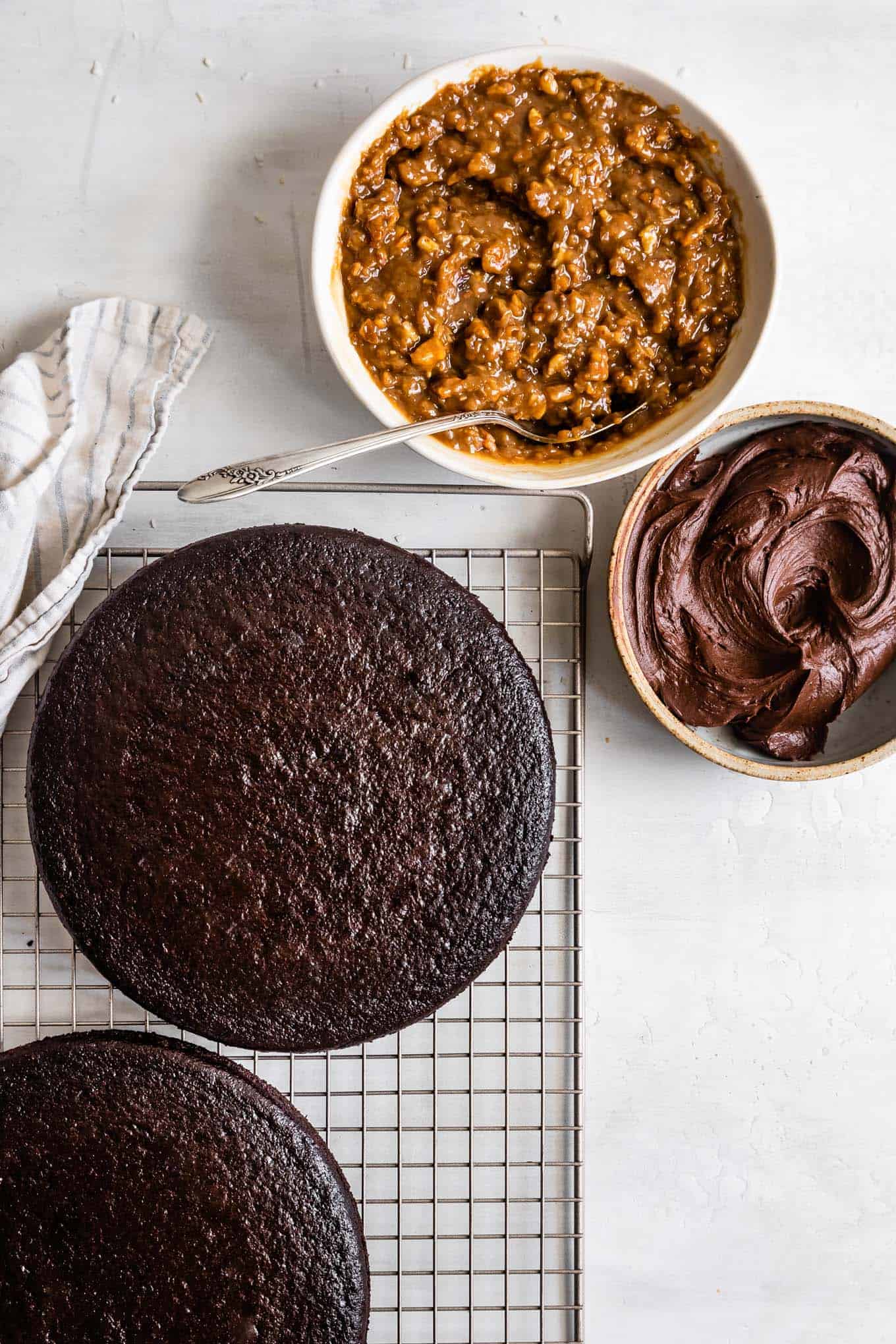

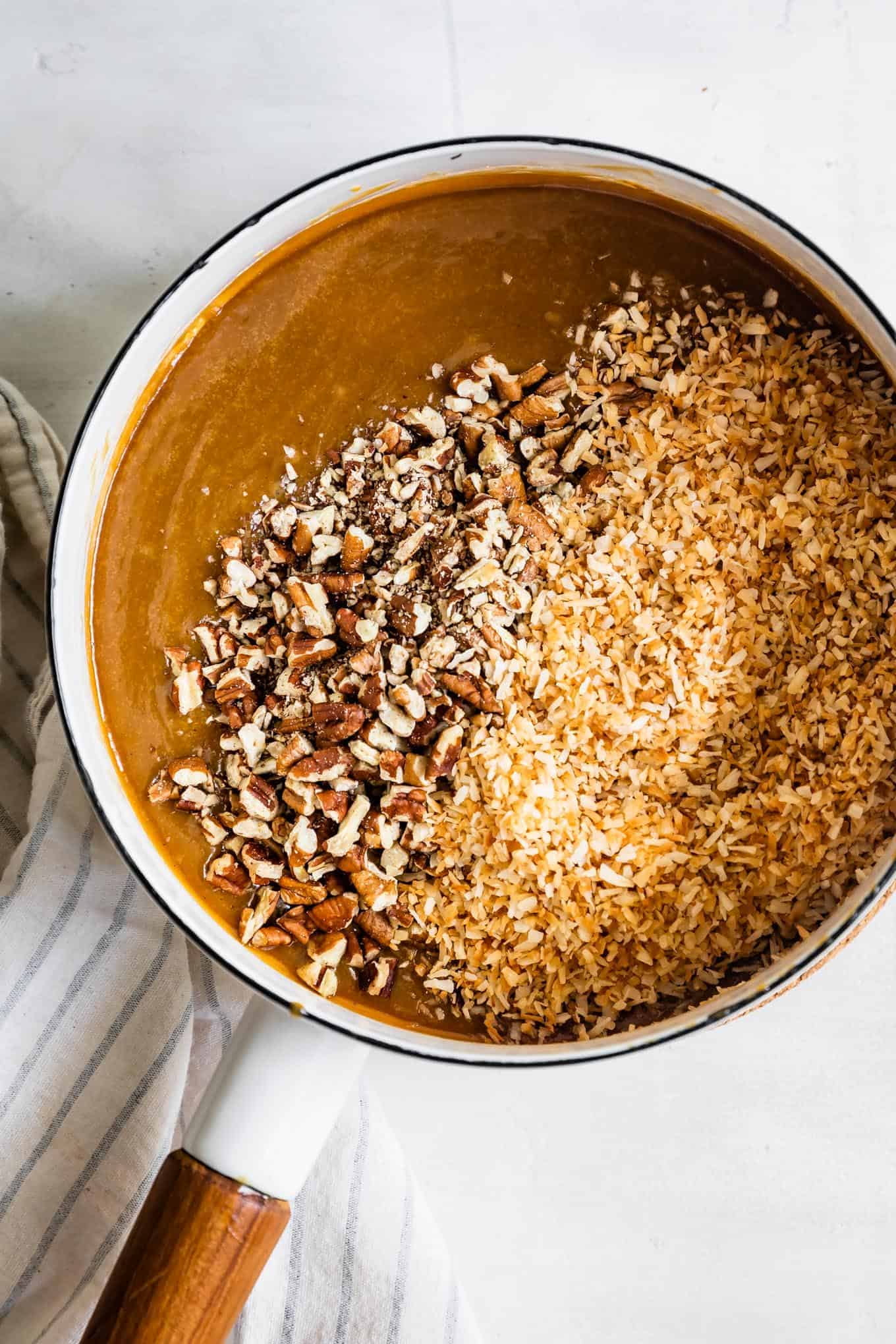
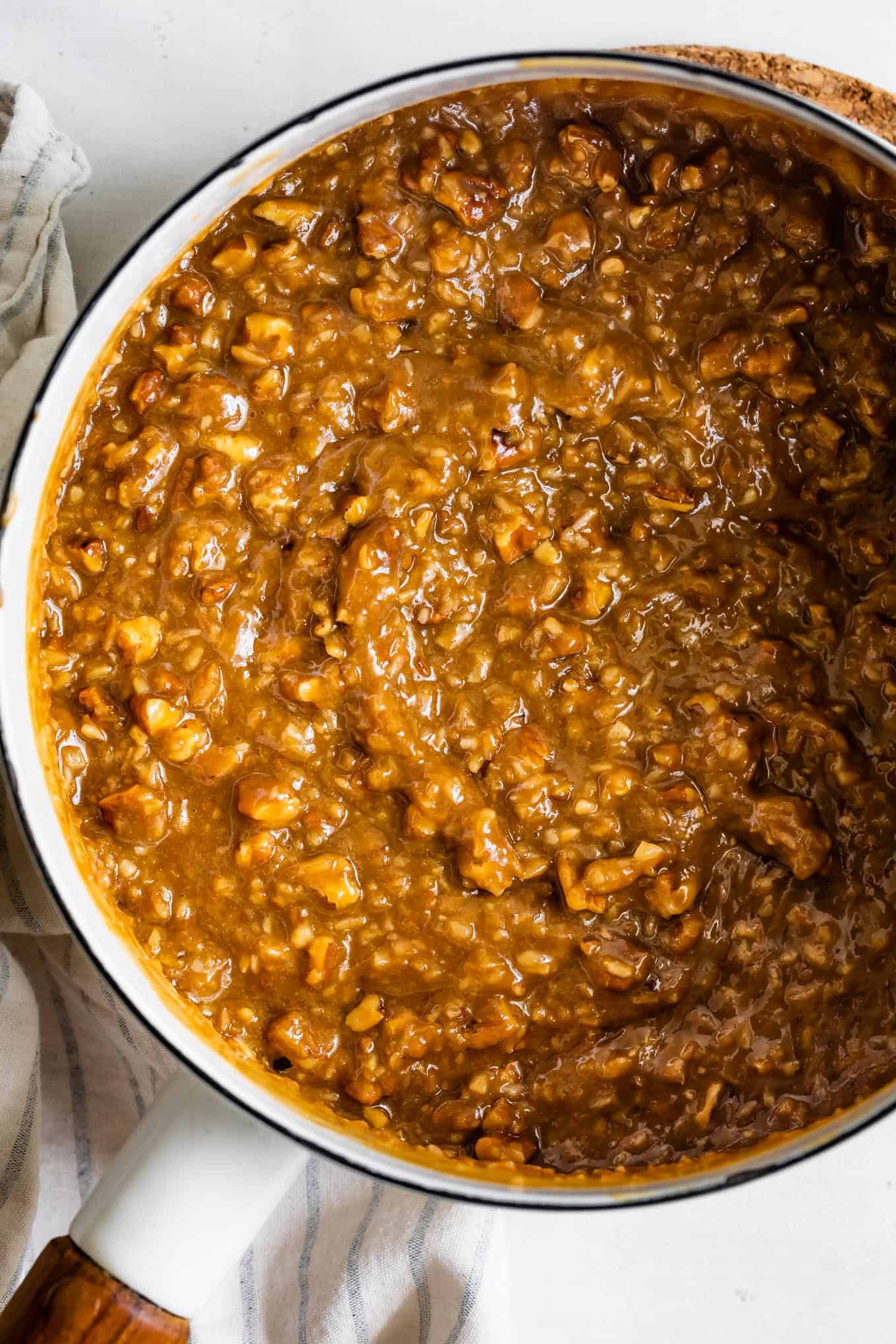
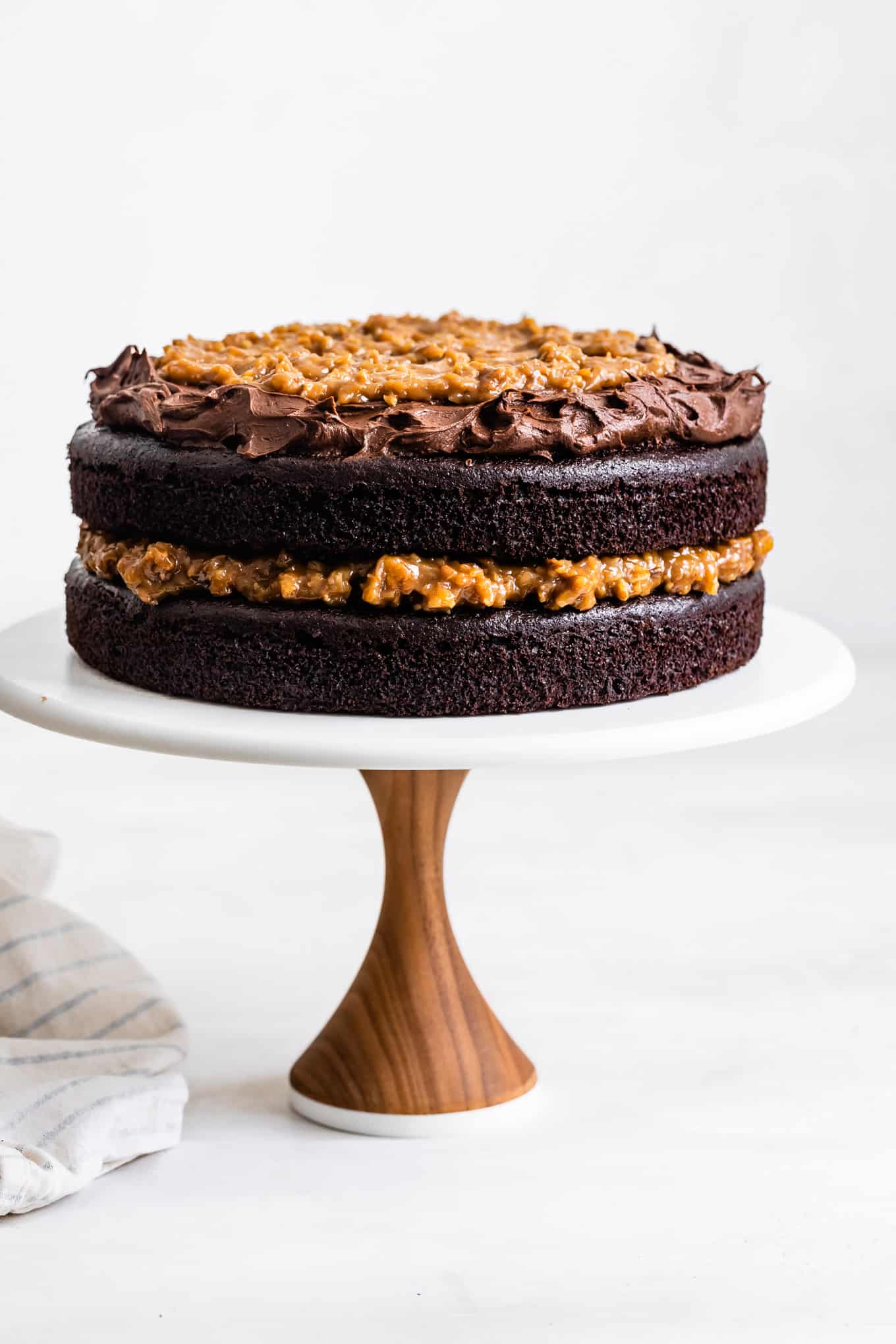

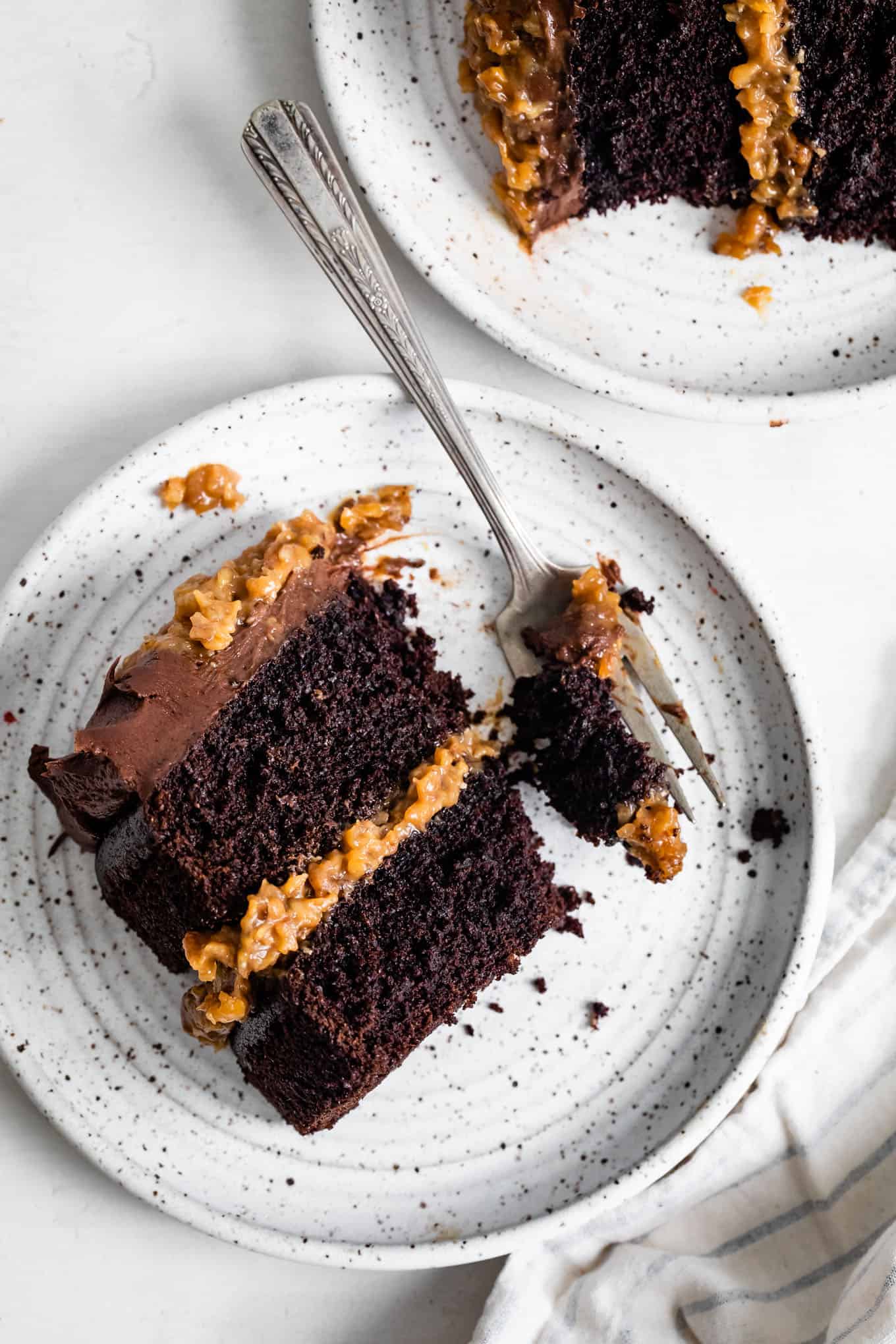
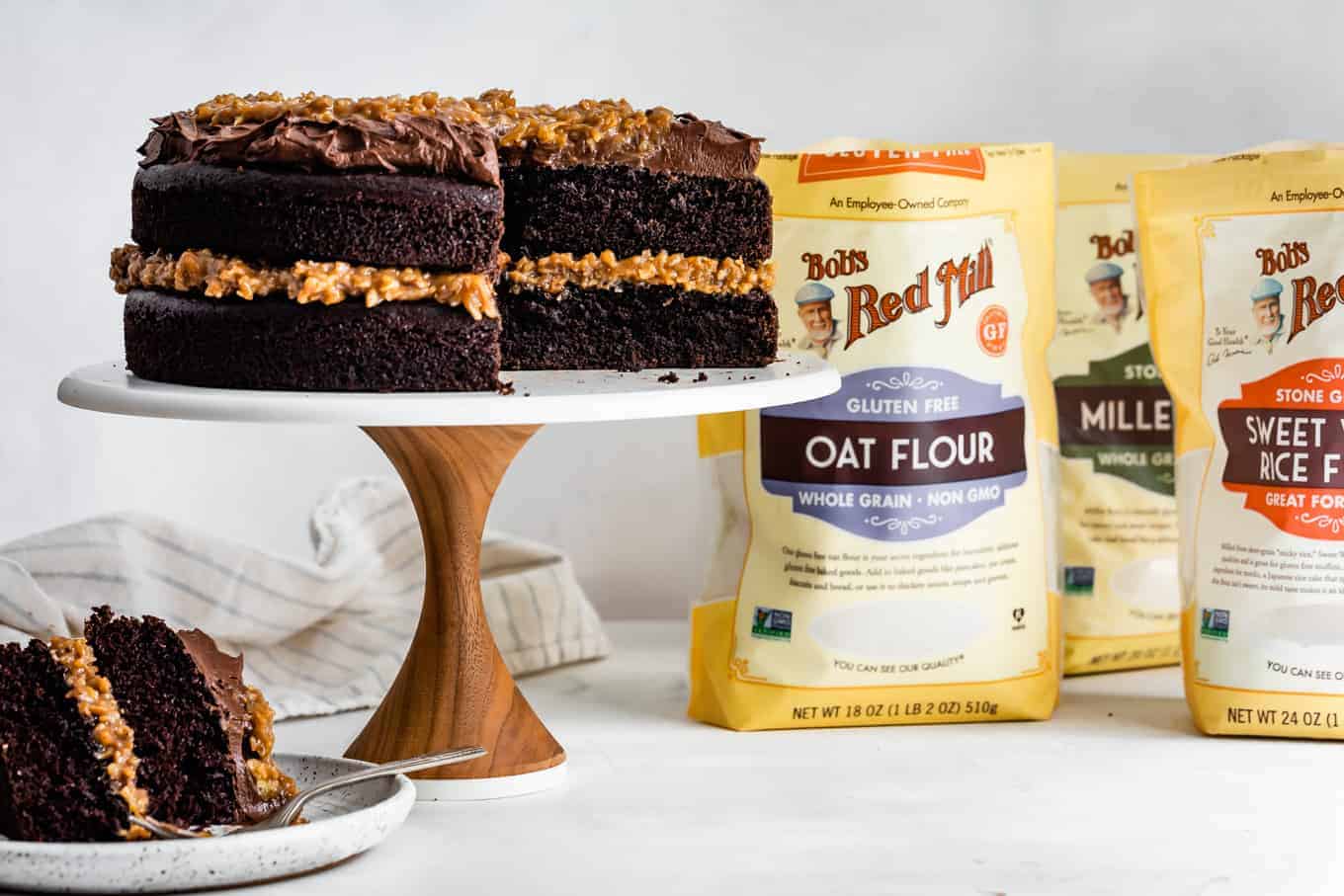









todd -
Ooey Gooey Chocolate Goodness!! Gonna try to bake this with Fiona soon :)
Lily Diamond -
The coconut pecan custard is EPIC!! I cannot wait to make this again.